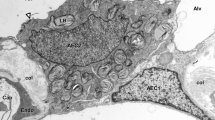Abstract
The effect of prednisolone on indirectly stimulated rat muscle twitch was investigated at normal and prostigmine-treated neuromuscular junctions. In vivo, predenisolone up to 150 mg/kg body weight did not affect twitch contraction in normal animals. In neostigmine-pretreated animals, however, doses between 12.5 and 90 mg/kg could entirely abolish the anticholinesterase-induced twitch augmentation. In vitro, prednisolone produced a depressant effect on the twitch of a normal phrenic nerve diaphragm preparation which could amount to 20%. When the preparation was pretreated with neostigmine the augmented twitch could be depressed by 10−3 to 10−6 mol/l prednisolone to levels below the untreated control. Part of this effect is owing to a suppression of the neostigmine-induced, stimulus-bound repetitive firing of the motor nerve terminals, but to explain the full effect a further inhibitory action on neuromuscular transmission must be assumed. The latter could be accounted for by a depolarizing interaction of prednisolone and neostigmine on the nerve terminals resulting in conduction block. An action of prednisolone on postsynaptic receptors could also be considered. Such effects of the glucocorticoid might contribute to the exacerbation of muscular weakness occasionally observed in patients with myasthenia gravis at the beginning of steroid therapy.
Similar content being viewed by others
References
Arts, W. F., Oosterhuis, H. J.: Effect of prednisolone on neuromuscular blocking in mice in vivo. Neurology (Minneap.)25, 1088–1090 (1975)
Baker, T., Riker, W. F., Hall, E. D.: Effects of a single methylprednisolone dose on a facilitatory response of mammalian motor nerve. Arch. Neurol.34, 349–355 (1977)
Birnberger, K. L., Struppler, A.: Einfluß von ACTH und Cortison auf die neuromuskuläre Übertragung: Elektrophysiologische Untersuchungen in vitro. In: Myasthenia Gravis (G. Hertel, H. G. Mertens, K. Ricker and K. Schimrigk, eds.). Stuttgart: Thieme-Verlag 1977
Birnberger, K. L., Rüdel, R., Struppler, A.: ACTH and neuromuscular transmission: electrophysiological in vitro investigation of the effects of corticotropin and an ACTH fragment on neuromuscular transmission. Ann. Neurol.1, 270–275 (1977)
Bretag, A. H.: Synthetic interstitial fluid for isolated mammalian tissue. Life Sci.8, 319–329 (1969)
Brunner, N. G., Berger, C. L., Namba, T., Grob, D.: Corticotropin and corticosteroids in generalized myasthenia gravis: comparative studies and role in management. Ann. N. Y. Acad. Sci.274, 577–595 (1976)
Hobbiger, F.: Pharmacology of anticholinesterase drugs. In: Neuromuscular junction. (E. Zaimis, ed.). Berlin, Heidelberg, New York: Springer 1976
Hofmann, W. W.: Antimyasthenic action of corticosteroids. Arch. Neurol34, 356–360 (1977)
Hubbard, J. I., Willis, W. D.: The effect of depolarization of motor nerve terminals upon the release of transmitter by nerve impulses. J. Physiol. (Lond.)194, 381–405 (1968).
Hubbard, J. I., Schmidt, R. F., Yokota, T.: The effect of acetylcholine upon mammalian motor nerve terminals. J. Physiol. (Lond.)181, 810–829 (1965)
Leeuwin, R. S., Wolters, E. C. M. J.: Effect of corticosteroids on sciatic nerve-tibialis anterior muscle of rats treated with hemicholinium. Neurology (Minneap.)27, 171–177 (1977)
Masland, R. L., Wigton, R. S. J.: Nerve activity accompanying fasciculation produced by prostigmine. J. Neurophysiol.3, 269–275 (1940)
Morrison, J. D.: Repetitive activity in the phrenic nervediaphragm preparation of rat. J. Physiol. (Lond.)256, 130P (1976)
Patten, B. M., Oliver, K. L., Engel, W. K.: Adverse interaction between steroid hormones and anticholinesterase drugs. Neurology (Minneap.)24, 442–449 (1974)
Randić, M., Straughan, D. W.: Antidromic activity in the rat phrenic nerve-diaphragm preparation. J. Physiol. (Lond.)173, 130–148 (1964)
Riker, W. F., Okamoto, M.: Pharmacology of motor nerve terminals. Annu. Rev. Pharmacol.9, 173–208 (1969)
Riker, W. F. Jr., Baker, T., Okamoto, M.: Glucocorticoids and mammalian motor excitability. Arch. Neurol.32, 688–695 (1975)
Van der Meer, C., Meeter, E.: The mechanism of action of anticholinesterases. The effect of diisopropylfluorophosphonate (DFP) on the isolated rat phrenic nervediaphragm preparation. Acta Physiol. Pharmacol. Neerl.4, 454–471 (1956)
Warmolts, J. R., Engel, W. K.: Remarkable benefit from alernate day prednison treatment in myasthenia gravis. Lancet1970II, 1198–1199
Wilson, R. W., Ward, M. D., Johns, T. R.: Corticosteroids: a direct effect at the neuromuscular junction. Neurology (Minneap.)24, 1091–1095 (1974)
Wolters, E. C. M. J., Leeuwin, R. S.: Effect of corticosteroids on the phrenic nerve-diaphragm preparation treated with hemicholinium. Neurology (Minneap.)26, 574–578 (1976)
Author information
Authors and Affiliations
Rights and permissions
About this article
Cite this article
Dengler, R., Rüdel, R., Warelas, J. et al. Corticosteroids and neuromuscular transmission: Electrophysiological investigation of the effects of prednisolone on normal and anticholinesterase-treated neuromuscular junction. Pflugers Arch. 380, 145–151 (1979). https://doi.org/10.1007/BF00582150
Received:
Issue Date:
DOI: https://doi.org/10.1007/BF00582150




